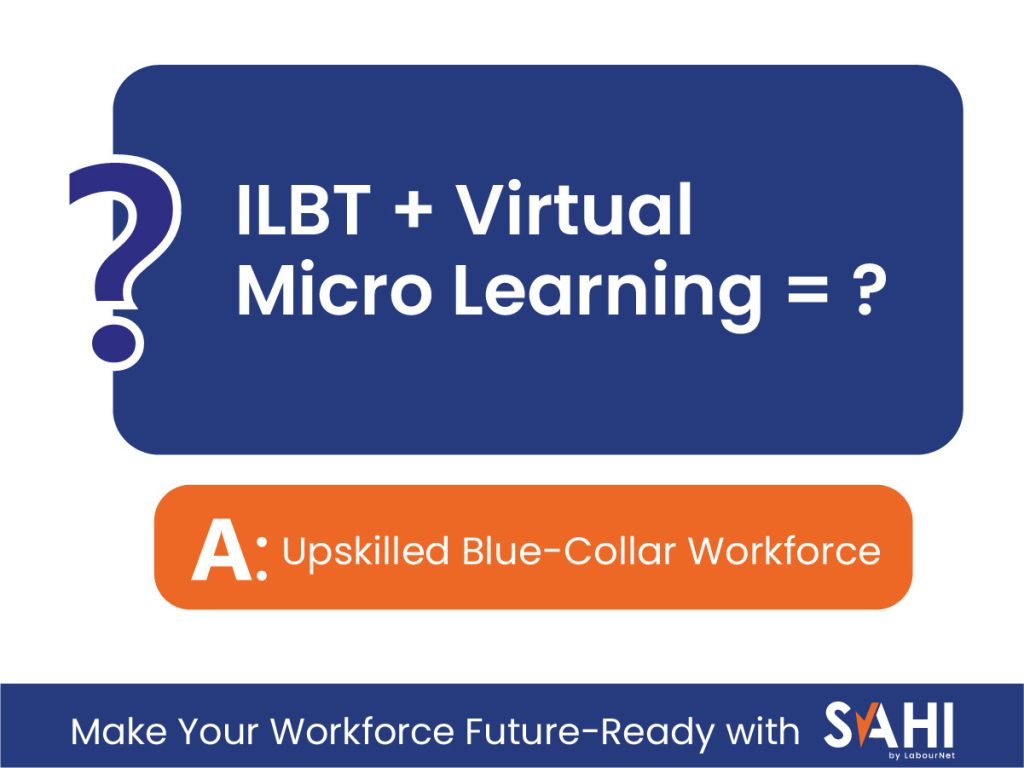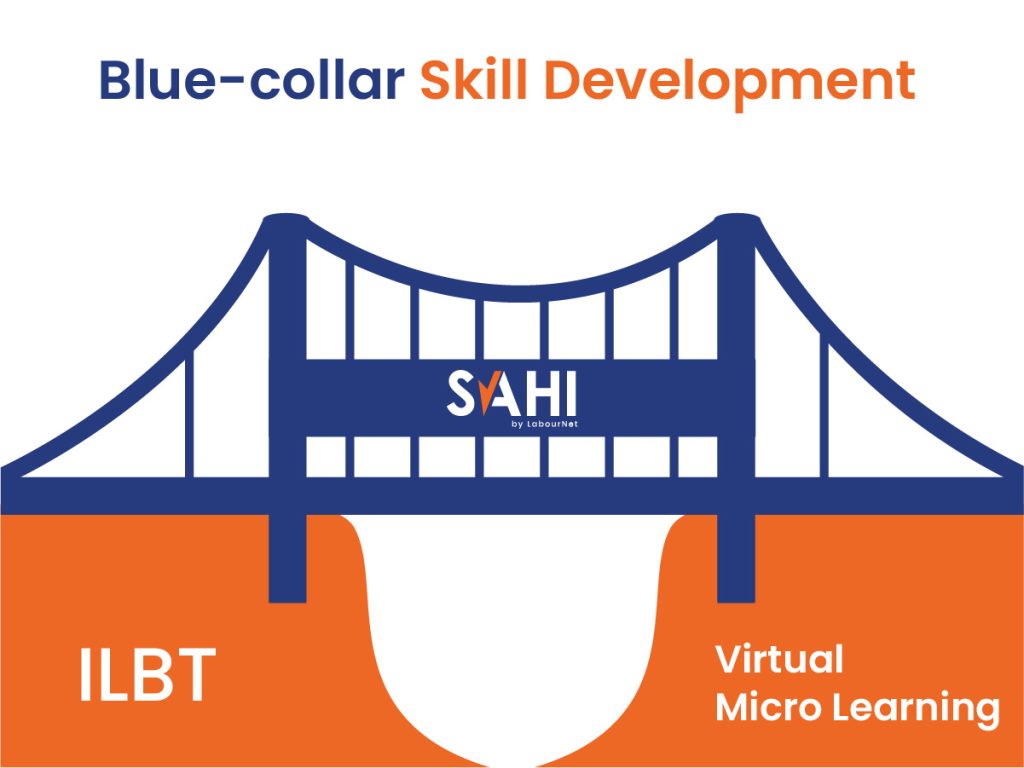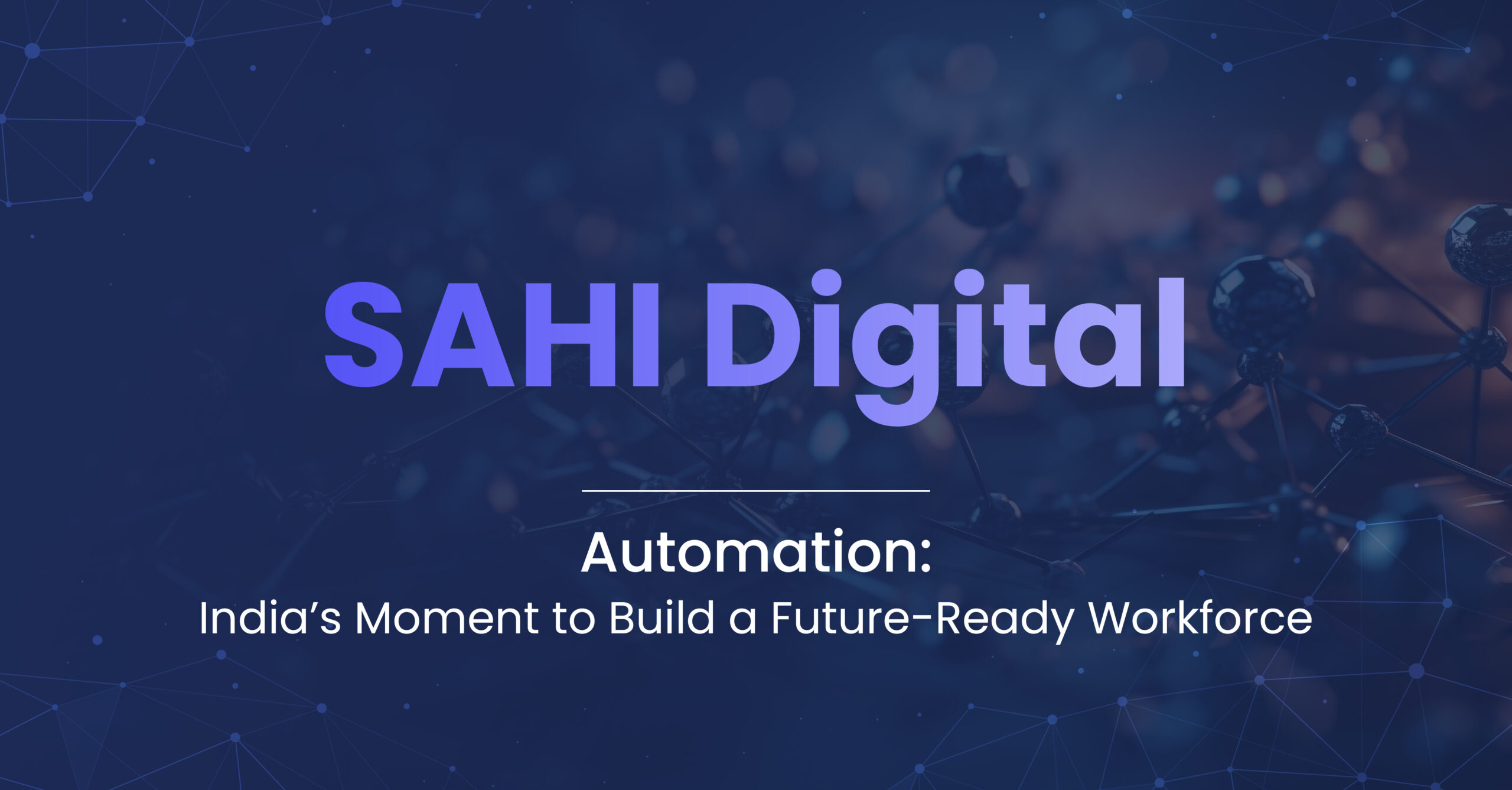As the digital wave continues to reshape the industrial landscape, the emphasis on skill development and continuous learning is soaring. And this is especially true for the blue-collar workforce.
The traditional classroom training methods are finding it hard to keep pace with the evolving job roles and the tech-savvy nature of modern manufacturing environments.
In this atmosphere, Instructor-led Blended Training (ILBT) and Virtual Micro-Learning emerge as beacons of innovative learning. They offer a tailored, interactive, and scalable approach to training development.
These modern methodologies, championed by solutions like SAHI, are not just addressing the training needs but are setting a new benchmark in employee training and development. Moreover, such training programs are especially crafted for the unique challenges and requirements of blue-collar workers.
Transitioning from Traditional to Digital Learning: A Necessary Shift
The educational ecosystem within the industrial sector is experiencing a paradigm shift from traditional to digital learning methodologies. Traditional learning, characterised by classroom-based instruction, has been the bedrock of skills development for decades.
However, as manufacturing processes become more sophisticated and digitalized, the need for a more dynamic and flexible learning approach is palpable.
The Shortcomings of Traditional Learning
Traditional learning models, though effective in a structured setting, often falter when it comes to scalability, customization, and engagement. This is particularly a problem for a diverse and dispersed blue-collar workforce.
The rigidity in learning paths, geographical limitations, and the high costs associated with setting up physical training sessions are some of the inherent drawbacks. Moreover, the one-size-fits-all approach seldom caters to the varied learning capacities of labour training and job roles of blue-collar workers.
The Digital Learning Revolution
Enter digital learning – a realm where interactive, engaging, and personalised learning paths are the norms. Digital learning, encompassing ILBT and Virtual Micro-Learning, is tailored for the digital age, offering flexibility, engagement, and a learner-centric approach.
Micro-Learning: Bite-Sized Learning for Better Retention
Microlearning, a cornerstone of digital learning, is particularly suited for the blue-collar workforce. It breaks down complex training material into bite-sized modules, making learning more digestible and less time-consuming.
This mobile learning solution is designed for on-the-go learning, ensuring that skill development is continuous and not confined to a classroom.
ILBT: Bridging the Digital Divide
Instructor-led Blended Training (ILBT) amalgamates traditional classroom instruction with digital learning resources. It’s a balanced approach that ensures the human touch in learning is retained while embracing the advantages of digital resources.
ILBT is instrumental in workforce upskilling, offering a structured yet flexible learning path.
The Imperative for Change
The transition towards digital learning is not a mere trend but a necessity driven by the digital transformation sweeping across the manufacturing sector. The ability to provide continuous, engaging, and customised training is pivotal for nurturing the skills of blue-collar workers.
Digital learning methodologies like those offered by SAHI not only address the skills gap but also foster a culture of continuous learning and improvement. As a result, it aligns with the evolving demands of the modern industrial workspace.
Instructor-led Blended Training (ILBT): A Harmonious Blend of Tradition and Innovation
Instructor-led Blended Training (ILBT) is a progressive learning methodology that marries traditional face-to-face instruction with digital resources. Thus, it can provide a rich, engaging, and flexible learning experience.
It’s particularly apt for blue-collar training programs, addressing the unique challenges and learning preferences of this workforce segment.
Components of ILBT
The ILBT model is composed of several integral components:
Face-to-Face Instruction:
- Personalised Attention from Instructors: This allows for real-time assessment, immediate feedback, and personalised guidance, which is essential for understanding complex tasks.
- Real-time Feedback and Clarification: Immediate feedback helps in correcting mistakes on the spot and clarifying doubts, which contributes to better understanding and retention.
- Hands-on Practical Training: Practical training provides a real-world understanding of the tasks and helps in honing the skills required in the field.
Online Learning Modules:
- Self-paced Learning: Individuals can learn at their own pace which reduces the pressure and enhances understanding.
- Video Tutorials, Quizzes, and Assessments: These digital resources provide a varied learning experience, making learning engaging and comprehensive.
- Availability of Resources: Having resources available for reference and revision promotes continuous learning.
Collaborative Learning Platforms:
- Forums and Discussion Boards: These platforms promote peer interaction, discussion, and problem-solving which can enhance understanding and retention.
- Shared Learning Experiences: Sharing and discussing real-world experiences can provide valuable insights.
- Community Support: A supportive community can enhance the learning experience, providing motivation, and a sense of belonging.
Seamless Integration:
- Integration of Online and Offline Learning Experiences: This creates a cohesive learning journey where digital resources complement in-person instruction.
- Tracking Progress: Digital platforms allow for tracking progress, identifying areas of improvement, and adapting the learning path accordingly.
Regular Skills Assessment:
- Continuous Assessment: Assessing skills regularly ensures that the training is effective and the desired learning outcomes are being achieved.
- Data-driven Insights: Analytics from digital platforms can provide valuable insights into the effectiveness of the training program, helping in making informed decisions for improvements.
Enhanced Engagement and Retention:
- Interactive and Varied Learning Resources: Variety and interactivity keep the learners engaged, which in turn, improves retention.
- Blend of Digital and Personal Interaction: The combination of digital resources and personal interaction provides a rich learning experience which can lead to better retention of knowledge.
Scalability and Flexibility:
- Training a Large Workforce: Digital resources make it feasible to train a large workforce across different locations.
- Flexibility to Learn: Individuals can learn at their convenience, making learning a continuous process rather than a one-time event.
Cost-Effectiveness:
- Reducing Logistical and Infrastructural Costs: Digital learning can significantly cut down the costs associated with traditional training methods.
- Reusable Digital Resources: Digital resources like video tutorials and online modules can be reused, making it a cost-effective solution for long-term training and development.
The ILBT model, with its balanced approach towards learning, is catalysing a significant positive change in the domain of blue-collar training programs.
It’s not just about delivering training; it’s about creating a conducive environment for continuous learning and development. This aligns well with the overarching goal of nurturing a competent and adaptable blue-collar workforce in the digital age.
Harnessing the Potency of Virtual Micro-Learning
Virtual Micro-Learning is an innovative approach to skills development, emphasising bite-sized learning modules delivered digitally. This methodology, being highly flexible and accessible, is fitting for blue-collar workers, offering a tailored learning journey.
Understanding Virtual Micro-Learning
Virtual Micro-Learning simplifies complex learning material by segmenting it into digestible, bite-sized modules. Digital delivery ensures that learning is accessible and convenient, especially beneficial for a geographically dispersed workforce.
- Bite-Sized Learning Modules
Virtual Micro-Learning segments complex training material into manageable, bite-sized modules, simplifying the learning process for blue-collar workers. Each module is designed to convey a specific concept or skill, ensuring that the learning objectives are clear and achievable.
This approach enables workers to grasp complex ideas at their own pace, promoting better understanding and retention of knowledge.
- Digital Delivery
Delivered virtually, Micro Learning ensures accessibility and convenience, providing learning opportunities irrespective of geographical barriers. This is a substantial advantage for companies with a geographically dispersed workforce.
It allows for a standardised training program across various locations, ensuring that every worker, regardless of their location, receives the same high-quality training.
Implementing Virtual Micro-Learning
Implementation involves customising content to cater to diverse learning needs. This means scaling to accommodate a large workforce, and including continuous assessments to gauge the effectiveness of the learning process.
These assessments provide real-time feedback, aiding in the immediate application of learned skills and continuous improvement.
- Customization and Scalability
The digital nature of Virtual Micro-Learning allows for customization to cater to diverse learning needs. It can be tailored to meet the specific requirements of different job roles within the blue-collar sector.
Furthermore, it’s scalable to accommodate training for a large workforce. Companies can deploy training modules to a vast number of employees simultaneously, ensuring that workforce upskilling is uniform and aligned with organisational goals.
- Continuous Assessment
Regular assessments and feedback are integral to Virtual Micro-Learning, ensuring effective learning and skills acquisition. Continuous assessment provides real-time feedback, aiding in the immediate application of learned skills and continuous improvement.
It also allows for tracking progress and identifying areas for improvement, enabling a data-driven approach to employee training and development.
Advantages of Virtual Micro-Learning
The advantages are manifold, while the engaging digital format and concise content improve retention rates. Cost-effectiveness comes from reduced logistical and infrastructural expenses compared to traditional training methods.
Lastly, the flexibility allows for learning at one’s convenience. Hence, it fosters a culture of continuous self-improvement, which is crucial for adapting to evolving roles and technologies in the blue-collar sector.
- Enhanced Engagement and Retention: Interactive digital formats and short, concise learning modules keep engagement high, promoting better retention of knowledge. The interactive nature of virtual micro-learning modules makes learning engaging and enjoyable, which in turn improves retention rates.
This is particularly beneficial in blue-collar training programs where keeping engagement levels high is crucial for effective skills transfer.
- Cost-Effectiveness: Virtual Micro-Learning is a cost-effective solution, significantly reducing the expenses associated with traditional training methods. The digital resources like video tutorials and online assessments are reusable, ensuring a cost-effective long-term solution for employee training and development.
This is a substantial benefit for organisations looking to optimise their training budgets while ensuring high-quality training for their blue-collar workforce.
- Flexibility and On-the-Go Learning: Virtual Micro-Learning provides the flexibility to learn at one’s convenience, promoting a culture of continuous learning and self-improvement. This is crucial for blue-collar workers who may have varying schedules.
The on-the-go learning approach ensures that skill development is continuous and not confined to a classroom. This means it aligns well with the busy schedules and evolving roles of blue-collar workers in the modern industrial workspace.
Each of these facets contributes to making Virtual Micro-Learning a potent tool for addressing the unique challenges associated with blue-collar training and skill development.
Maximising Impact through ILBT and Virtual Micro-Learning Integration

SAHI, with its innovative approach, seamlessly integrates Instructor-led Blended Training (ILBT) and Virtual Micro-Learning, creating a powerful training framework for blue-collar skill development.
This fusion not only enhances the learning experience but significantly drives the effectiveness of training programs.
- Tailored Learning Paths
SAHI meticulously crafts learning paths, ensuring they cater to the diverse learning paces and skill levels of blue-collar workers. This individualised approach enhances engagement, making learning an enriching experience.
The tailored programs ensure that each worker gains the necessary skills, fostering a competent and adaptable workforce.
- Scalable Learning Solutions
SAHI’s learning solutions are designed for scalability, accommodating large workforces across different geographical locations. This is crucial in bridging skills gaps on a substantial scale, ensuring that all workers, irrespective of location, have access to high-quality training.
Thus, it promotes a uniformly skilled workforce which is pivotal for operational excellence.
- Continuous Assessment and Feedback
SAHI integrates continuous assessment and feedback into the learning journey, providing real-time insights into each worker’s progress. This data-driven approach allows for immediate feedback, aiding in the swift application of learned skills, and identifying areas for improvement.
Hence, it fosters a culture of continuous learning and improvement.
- Measurable Impact
By harmonising ILBT and Virtual Micro-Learning, SAHI enables a data-driven approach to measure the training programs’ impact. Assessing the effectiveness of training on workforce performance and operational efficiency becomes feasible.
Thus, it provides valuable insights that can be used to further refine training programs, aligning them with organisational goals.
- Long-term Cost Efficiency
SAHI emphasises long-term cost efficiency by providing reusable digital resources. The reduction in logistical and infrastructural costs associated with traditional training methods is significant.
This cost-effective approach ensures that organisations can invest in continuous training programs, nurturing a well-trained, adaptable workforce without straining their budgets.
- Strategic Partnership
Working in a strategic partnership model, SAHI aligns its training programs with the organisation’s broader goals. This alignment ensures that the training programs are not just effective but are instrumental in achieving the desired outcomes in blue-collar skill development.
As a result, it fosters a mutually beneficial relationship that drives organisational success.
The Need For Modern Training Methods
In the fast-evolving industrial landscape, the necessity for effective, engaging, and scalable training methodologies for the blue-collar workforce is more crucial than ever. The fusion of Instructor-led Blended Training (ILBT) and Virtual Micro-Learning presents a revolutionary step towards addressing this necessity.
ILBT brings forth the essential personalised touch, ensuring that complex concepts are well-understood and skills are honed under expert guidance. On the other hand, Virtual Micro-Learning caters to the digital age’s demand for flexible, self-paced learning.
It segments complex training material into digestible, bite-sized modules, making learning an engaging and manageable endeavour.
SAHI’s pioneering approach in harmoniously integrating these two potent methodologies demonstrates a progressive step towards addressing the unique training challenges associated with the blue-collar workforce. This integration ensures a comprehensive, engaging, and effective training program that caters to varied learning paces and skill levels.
Hence, it makes skill development a continuous, self-driven endeavour.
Moreover, the scalability of this blended approach ensures that training programs can be efficiently deployed across a geographically dispersed workforce. Thus, bridging the skills gap on a substantial scale.
The continuous assessment feature embedded within this approach ensures real-time feedback and data-driven insights. Hence, it fosters a culture of continuous improvement and skill enhancement.
What Role Does SAHI Play?

The long-term cost efficiency and the strategic partnership model adopted by SAHI underline the profound impact such an innovative approach to training can have on organisational success.
By aligning training programs with organisational goals, SAHI ensures that the desired outcomes in blue-collar skill development are achieved.
The seamless integration of ILBT and Virtual Micro-Learning is not merely a modern approach to training. But it’s a significant leap towards building a competent, adaptable, and future-ready blue-collar workforce.
This revolution in training methodologies is an investment that promises a robust foundation for organisational success in the competitive industrial landscape. And it ensures that organisations are well-poised to navigate the challenges of the digital age.
Unleash the Full Potential of Your Blue-Collar Workforce
Are you ready to transform your blue-collar training programs?
SAHI’s innovative approach integrating ILBT and Virtual Micro-Learning is the solution you’ve been searching for. Don’t let geographical barriers or varied learning paces hinder your workforce’s skill development.
Reach out to SAHI now to discover more about these modern learning methodologies. Schedule a demo to witness firsthand how our tailored training solutions can revolutionise your blue-collar workforce training.
This will propel your organisation towards operational excellence. Your journey towards creating a competent, adaptable, and future-ready workforce begins here.


